Vortigern
Studies Index










.Wansdyke Project 21
is part of
Vortigern Studies

|
|
A
Visit to Wansdyke - Milk Hill
My first visit to Wansdyke went by almost
completely unnoticed, as I was 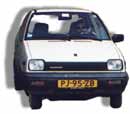 not familiar with the territory.
The second one fared hardly any better, for
there was nothing to be seen from the road. The third
time I came prepared. My wife and I (we got married in
the meantime) came by car (no more bikes!) and stayed for
the week at the Old Rectory in lovely All Cannings. This
small sleepy village lies just south of the ridge of the
Downs in the Vale of Pewsey, right on the doorstep of
Wansdyke, so to speak. not familiar with the territory.
The second one fared hardly any better, for
there was nothing to be seen from the road. The third
time I came prepared. My wife and I (we got married in
the meantime) came by car (no more bikes!) and stayed for
the week at the Old Rectory in lovely All Cannings. This
small sleepy village lies just south of the ridge of the
Downs in the Vale of Pewsey, right on the doorstep of
Wansdyke, so to speak.
We had
visited Glastonbury for the second time the other day, so
it was time to stretch 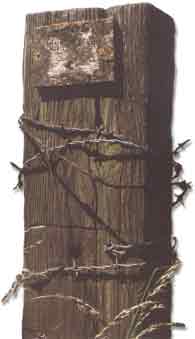 the legs and go where I had planned to go:
Wansdyke. We parked our car on the little parking lot so
often used by hangglider-enthousiasts, and went for our
few miles (4,5 km) walk. The track crosses a few fields
and joins the old Ridgeway halfway up the slope, which
turns towards a small gap. Though seemingly just a short
walk, the high winds and temperatures made it the legs and go where I had planned to go:
Wansdyke. We parked our car on the little parking lot so
often used by hangglider-enthousiasts, and went for our
few miles (4,5 km) walk. The track crosses a few fields
and joins the old Ridgeway halfway up the slope, which
turns towards a small gap. Though seemingly just a short
walk, the high winds and temperatures made it 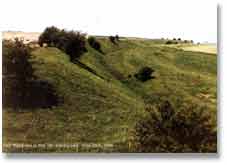 somewhat more than a stroll. The
views made quite up for that though. First, on leaving
the carpark at the old 'Workway Drove', the path follows
a comb out of the Vale of Pewsey, sweeping gently up the
hillside with the Vale of Pewsey in the distance. At some
Point, the Great Ridgeway sweeps off to the right,
crossing the Dyke in the woods on its way to Avebury.
When you follow the fenceline, the track passes an
ancient enclosure, probably Iron Age, known as the Eald
Burgh, the 'Old Fort'. The view to the south-east
now shows Knap Hill, Walker's Hill and Adam's Grave, all
showing signs of early occupation. somewhat more than a stroll. The
views made quite up for that though. First, on leaving
the carpark at the old 'Workway Drove', the path follows
a comb out of the Vale of Pewsey, sweeping gently up the
hillside with the Vale of Pewsey in the distance. At some
Point, the Great Ridgeway sweeps off to the right,
crossing the Dyke in the woods on its way to Avebury.
When you follow the fenceline, the track passes an
ancient enclosure, probably Iron Age, known as the Eald
Burgh, the 'Old Fort'. The view to the south-east
now shows Knap Hill, Walker's Hill and Adam's Grave, all
showing signs of early occupation.
Then a
great earthwork appeared at the horizon - Wansdyke!
(above, click here to enlarge). This is Wansdyke at
a 'shore', one of the few original openings known (there
are lots more of them these days, but they're made for
the cattle and stuff).
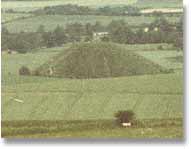 A A nd then..the view! We could see
from the woods in the east, right across the Kenneth Vale
in the north with Silllbury Hill (left and right, click here and here to enlarge)
very visible in the middle. Wansdyke looks really massive
here, with a deep ditch in front of it. Small wonder this
is looked at as very different from the western part of
Wansdyke, which is ploughed down along large parts of its
course. nd then..the view! We could see
from the woods in the east, right across the Kenneth Vale
in the north with Silllbury Hill (left and right, click here and here to enlarge)
very visible in the middle. Wansdyke looks really massive
here, with a deep ditch in front of it. Small wonder this
is looked at as very different from the western part of
Wansdyke, which is ploughed down along large parts of its
course.
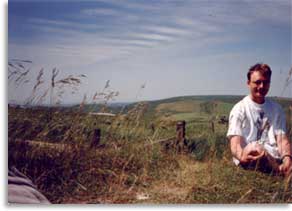 But luckily, the Marlborough
Downs have never come under the plough due to their
chalky geology, which is why this monument continues to
be close to as impressive as it once was, as you can see
from this picture (click here to enlarge). But luckily, the Marlborough
Downs have never come under the plough due to their
chalky geology, which is why this monument continues to
be close to as impressive as it once was, as you can see
from this picture (click here to enlarge).
Following
the road (or rather, the sparse signs of a track) up
towards Tan Hill, you cannot but marvel at the fantastic
views to the north. Silbury Hill and the Megalithic stone
circle of Avebury are quite visible (though bringing
along binoculars is always to be recommended), as are the
hill-forts of Liddington (where once Arthur fought?) and
Martinsell to the east. We followed the track across Milk
Hill, taking in the views of the Downs and Wandyke, which
runs up to Tan Hill, where the dyke curves out of sight
towards its end at Morgan's Hill, where it crosses and
cuts through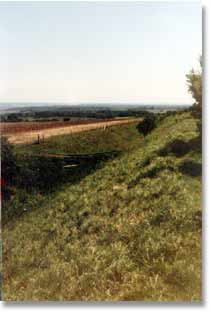 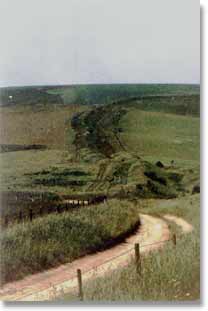 the Roman road that once ran from London
to Bath, only 8 kms away. Tan Hill, where the Dyke runs
across on it's course to the west, is derived from 'St.
Anne's Hill', and had been the place of an annual fair on
St. Annes Day (26-27 July) from at least 1499 up to the
last one in 1932. The Dyke gets quite steep here, and the Roman road that once ran from London
to Bath, only 8 kms away. Tan Hill, where the Dyke runs
across on it's course to the west, is derived from 'St.
Anne's Hill', and had been the place of an annual fair on
St. Annes Day (26-27 July) from at least 1499 up to the
last one in 1932. The Dyke gets quite steep here, and
its course, following the curve of the escarpment, is a
deep scar in the landscape.
To the back
of the Dyke lies the Pewsey Downs National Nature
Reserve, with many protected plants and flowers, but also
many sheep that need dodging (below, click here to enlarge). This not only
improves the landscape, it also attracts all kinds of
small wildlife. But flowers have other qualities...
 Of course, this is a visit to
Wansdyke, so something had to go wrong, I know you're
just waiting for it. Well, it did, twice in fact. My wife
has always been sensitive to hayfever, and that day the
pollen count went sky-high. You know, fabulous weather,
no wind, a flower reserve close by...and only one hanky.
You can imagine the results. Of course, this is a visit to
Wansdyke, so something had to go wrong, I know you're
just waiting for it. Well, it did, twice in fact. My wife
has always been sensitive to hayfever, and that day the
pollen count went sky-high. You know, fabulous weather,
no wind, a flower reserve close by...and only one hanky.
You can imagine the results.
 At that point, after about 500 metres
along the top of the dyke, the track veers to the left.
This is Milk Hill, and descending along it you can see
the villages in the Vale before you. We finished our walk
in beautiful beautiful weather, and managed to find the
White Horse we'd seen so many times from the valley
floor. The Horse (1812) is quite large (click here to enlarge), and much better
recognizable from a short distance. This in contrast to
the Uffington White Horse, which is much more ancient and
quite vague when you're standing next to it... We
completed the round trip to Adam's Grave (once Wodensbeorgh,
'Woden's Barrow') in a blistering heat of at least At that point, after about 500 metres
along the top of the dyke, the track veers to the left.
This is Milk Hill, and descending along it you can see
the villages in the Vale before you. We finished our walk
in beautiful beautiful weather, and managed to find the
White Horse we'd seen so many times from the valley
floor. The Horse (1812) is quite large (click here to enlarge), and much better
recognizable from a short distance. This in contrast to
the Uffington White Horse, which is much more ancient and
quite vague when you're standing next to it... We
completed the round trip to Adam's Grave (once Wodensbeorgh,
'Woden's Barrow') in a blistering heat of at least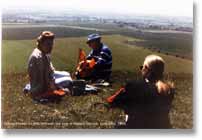 27 degrees centigrade, but we
met some nice people on the way. The girls managed a
lively discussion (left, click here to enlarge) 27 degrees centigrade, but we
met some nice people on the way. The girls managed a
lively discussion (left, click here to enlarge) 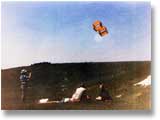 about the
Big Bang and the nature of Light - Philippine has a PhD
in Physics, while he showed me a strange kind of kite
(right), which turned out to be a WW2 distress gadget for
the radio arials of downed pilots.. I forgot to take down
their names properly, so if anyone knows them, please
mail me! We also managed to visit Avebury that afternoon,
but it was hot and the pollen still managed to lessen the
joy of revisiting that great site. On the way home, we
again saw the White Horese, gleaming brightly in the late
afternoon sun agains the dark hills. Brilliant. about the
Big Bang and the nature of Light - Philippine has a PhD
in Physics, while he showed me a strange kind of kite
(right), which turned out to be a WW2 distress gadget for
the radio arials of downed pilots.. I forgot to take down
their names properly, so if anyone knows them, please
mail me! We also managed to visit Avebury that afternoon,
but it was hot and the pollen still managed to lessen the
joy of revisiting that great site. On the way home, we
again saw the White Horese, gleaming brightly in the late
afternoon sun agains the dark hills. Brilliant.
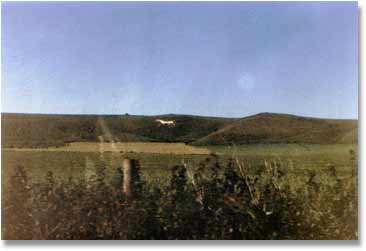
The other
thing we noticed only two weeks later, when we had
arrived back home and had our pics developed. It seemed I
had somehow managed to adjust the camera to 400 ASA, with
only a 100 ASA film inside.. That's why there are only a
few decent pictures of the Wansdyke trip, and I did not
shoot them! Although I was quite mad at myself for such
stupidity (we lost a week's pictures, something I
wouldn't wish on anyone).
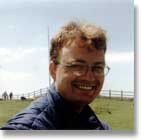 The rest of the holidays went
fine, thank you. We spent our second The rest of the holidays went
fine, thank you. We spent our second
week in good weather near Bude (Cornwall), where
I managed to celebrate
my 30st birthday in Tintagel (right, click here to enlarge) - not a bad
place for
an Arthurian enthousiast!
|
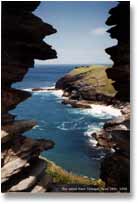 |
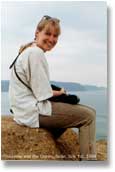 But even better than the
many Arthurian sights in thgis western tip of
Britain are the views.. Endless waves (click here to enlarge) seen across
lush green hills - we could not get enough of it! But even better than the
many Arthurian sights in thgis western tip of
Britain are the views.. Endless waves (click here to enlarge) seen across
lush green hills - we could not get enough of it!
|
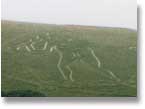 The last week we spent in
Sutton Waldron (Dorset), visiting more Arthurian
sites and other very beautiful spots. One such
was the 155ft. high Cerne Abbas Giant (click here to enlarge), cut out
into the turf high above a beautiful little
valley. This may represent Hercules, but
naughtier ideas have The last week we spent in
Sutton Waldron (Dorset), visiting more Arthurian
sites and other very beautiful spots. One such
was the 155ft. high Cerne Abbas Giant (click here to enlarge), cut out
into the turf high above a beautiful little
valley. This may represent Hercules, but
naughtier ideas have 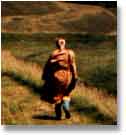 been put forward..
Another was Maiden Castle (click here to enlarge), the largest
iron Age hillfort of Britain, and surely the
strongest! been put forward..
Another was Maiden Castle (click here to enlarge), the largest
iron Age hillfort of Britain, and surely the
strongest!
|
|
 However, these triple
banks could not withstand the Roman onslaught.
Neither could its neighbour, Badbury Rings (click
here to enlarge), but at
least this hillfort-in-name-only continued as a
settlement (called Vindocladia), mainly
because two Roman roads cross here. Badbury, I
fear mainly because of the name, is a major
candidate for the famous, yet elusive Arthurian
battle of Badon Hill. However, even though the
views are breathtaking, I would not immediately
call it a 'hill'. Very Arthurian is also South
Cadbury! However, these triple
banks could not withstand the Roman onslaught.
Neither could its neighbour, Badbury Rings (click
here to enlarge), but at
least this hillfort-in-name-only continued as a
settlement (called Vindocladia), mainly
because two Roman roads cross here. Badbury, I
fear mainly because of the name, is a major
candidate for the famous, yet elusive Arthurian
battle of Badon Hill. However, even though the
views are breathtaking, I would not immediately
call it a 'hill'. Very Arthurian is also South
Cadbury!  At this very imposing and
beautiful hillfort (click here to enlarge), a major
post-Roman restructuring of the defences was
detected, and with Arthurian connections in place
for centuries..was this Camelot? Come and see for
yourself, as I've done twice by now (it never
gets boring). Climb up to Artur's Palace, see the
Arthurian gate, or get chased by Arthur's
Cattle.. At this very imposing and
beautiful hillfort (click here to enlarge), a major
post-Roman restructuring of the defences was
detected, and with Arthurian connections in place
for centuries..was this Camelot? Come and see for
yourself, as I've done twice by now (it never
gets boring). Climb up to Artur's Palace, see the
Arthurian gate, or get chased by Arthur's
Cattle..
|
As you can see, the pictures were fine,
thank goodness! All the more shame we lost those of
Wansdyke (although now, seven years later, I marvel at
what can be salvaged by using the combination of a
reasonably good scanner and even better imaging
software...). I made a vow to return: we'd have to come
back some time to shoot those again. We would, visiting
both West and East Wansdyke, two years later.
|